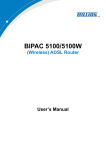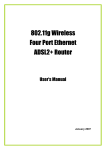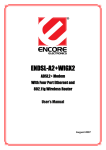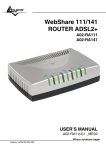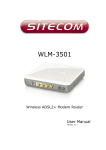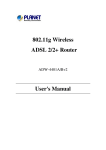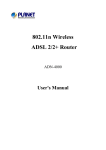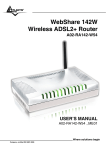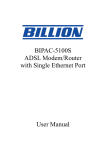Download Crypto WF200 Installation guide
Transcript
WF200 802.11g Wireless Four Port Ethernet ADSL2+ Modem Router Manual Version 1.0 WF200 802.11g Wireless Router Contents 1. Introduction................................................................................................................... 5 1.1 Introduction....................................................................................................... 5 1.2 Product Features ............................................................................................... 5 2. Hardware Installation.................................................................................................... 7 2.1 System Requirements ....................................................................................... 7 2.2 Package Contents .............................................................................................. 8 2.3 Front Panel Indicators and Description.......................................................... 8 2.4 Back Panel ......................................................................................................... 8 2.5 Connect Related Devices .................................................................................. 8 3. Connecting Wireless ADSL2+ Router via Ethernet...................................................... 9 3.1 Setup Wireless ADSL2+ router via Ethernet Cable....................................... 9 3.2 Configure TCP/IP ............................................................................................. 9 4. Configure Wireless ADSL2+ Router via HTML ........................................................ 22 4.1 Login................................................................................................................. 22 4.2 Navigating the Web Configurator ................................................................. 23 5. Interface Setup ............................................................................................................ 24 5.1 Internet............................................................................................................. 25 5.1.1 ATM VC & QoS ........................................................................................... 25 5.1.2 Encapsulation ............................................................................................... 26 5.2 LAN .................................................................................................................. 29 5.2.1 Router Local IP ............................................................................................ 29 5.2.2 Explaining RIP Setup .................................................................................. 29 5.2.3 DHCP Server ................................................................................................ 30 5.2.4 DHCP Relay.................................................................................................. 30 5.2.5 DNS Relay..................................................................................................... 31 5.3 Wireless ............................................................................................................ 32 5.3.1 Access Point Settings.................................................................................... 32 5.3.2 Multiple SSIDs Settings............................................................................... 33 5.3.3 WDS Settings ................................................................................................ 33 5.3.4 Wireless MAC Address Filter ..................................................................... 33 6 Advanced Setup ........................................................................................................... 34 6.1 Firewall ............................................................................................................ 34 2 WF200 802.11g Wireless Router 6.2 Routing............................................................................................................. 34 6.3 NAT .................................................................................................................. 35 6.3.1 What NAT Does............................................................................................ 36 6.3.2 How NAT Works .......................................................................................... 37 6.3.3 NAT Application........................................................................................... 37 6.3.4 NAT Mapping Types .................................................................................... 37 6.3.5 DMZ .............................................................................................................. 38 6.3.6 Virtual Server ............................................................................................... 38 6.3.7 IP Address Mapping .................................................................................... 39 6.4 QoS ................................................................................................................... 40 6.6 ADSL ................................................................................................................ 42 7.1 ACL .................................................................................................................. 43 7.2 Filter ................................................................................................................. 44 7.3 SNMP ............................................................................................................... 47 7.4UPnP.................................................................................................................. 47 7.5DDNS................................................................................................................. 48 7.6CWMP .............................................................................................................. 48 8. Maintenance................................................................................................................ 50 8.1 Administration................................................................................................. 50 8.2 Time Zone ........................................................................................................ 50 8.3 Firmware.......................................................................................................... 51 8.4 System Restart................................................................................................. 51 8.5 Diagnostic......................................................................................................... 52 9. Status........................................................................................................................... 52 9.1 Device Info ....................................................................................................... 52 9.2 System Log....................................................................................................... 54 9.3 Statistics ........................................................................................................... 54 10. Troubleshooting ........................................................................................................ 56 10.1 Using LEDs to Diagnose Problems .............................................................. 56 10.1.1 Power LED........................................................................................56 10.1.2 LAN LED..........................................................................................56 10.1.3 ADSL LED........................................................................................56 10.2 Problems with the Web Interface ................................................................ 56 10.3 Problems with the Login Username and Password ................................... 57 10.4 Problems with LAN Interface...................................................................... 57 3 WF200 802.11g Wireless Router 10.5 Problems with WAN Interface ..................................................................... 57 10.6 Problems with the Internet Access .............................................................. 58 11. Technical Support...................................................................................................... 59 4 WF200 802.11g Wireless Router 1. Introduction 1.1 Introduction This full rate Wireless ADSL2+ router is an all-in-one gateway for Home and SOHO applications. This gateway is with full-featured ADSL router that provides high-speed Internet access, 4-port Ethernet switch direct connections to individual PCs or local area network with 10/100 Base-T Ethernet and 54Mbps IEEE802.11g wireless connectivity. This device uses an advanced ADSL chipset solution with complete set of industry standard features for high-speed Internet access. Also built-in 54Mbps IEEE802.11g wireless service can provide you easy and convenient way to connect the PCs and Internet. User can enjoy higher quality multimedia and real-time applications such as online gaming, Video-on-Demand, VoIP and other bandwidth consuming services. Also the feature-rich routing functions are seamlessly integrated to ADSL service for existing corporate or home users. This product is made in ISO9001 approved factory and complies with FCC part15 regulations and CE approval. 1.2 Product Features Application Diagram IP Phone / Video Phone Wireless Router IP Phone / PDA / NB High Speed Internet Access This Wireless ADSL2+ router complies with ADSL / ADSL2 / ADSL2+ standards. It can support downstream rates of up to 24Mbps and upstream rates of up to 1Mbps. This ADSL2+ router is compliant with the following standards. z ANSI T1.413 issue 2 z ITU-T G.992.1 (G.dmt) 5 WF200 802.11g Wireless Router z ITU-T G.992.2 (G.lite) z G.994.1 (G.hs, Multimode) z ITU-T G.992.3 (ADSL2 G.dmt.bis) z ITU-T G.992.4 (ADSL2 G.lite.bis) z ITU-T G.992.5 (ADSL2+; Annex A, B, I, J, L & M) z Reach Extended ADSL (RE ADSL) Quick Setup Wizard Support Quick Setup Wizard Web GUI and Easy setup software to install this Wireless ADSL2+ router easily and quickly. Multi-connection protocol support z Multi Protocol over AAL5 (RFC1483 / 2684) z Classical IP over ATM (RFC 1577) z VC and LLC Multiplexing z PPP over Ethernet (RFC 2516) z PPP over ATM (RFC 2364) z Supports OAM F4/F5 loop-back, AIS and RDI OAM cells. z ATM Forum UNI 3.1/4.0 PVC z Support up to 8PVCs. z Traffic Shaping (ATM QoS) UBR, CBR, VBR-rt, VBR-nrt Network Address Translation (NAT) Network Address Translation (NAT) allows the translation of an Internet protocol address used within one network (for example a private IP address used in a local network) to a different IP address known within another network (for example a public IP address used on the Internet). Universal Plug and Play (UPnP) Universal Plug and Play is a standard that uses Internet and Web protocols to enable devices such as PCs, peripherals, intelligent appliances, and wireless devices to be plugged into a network and automatically know about each other. This protocol is used to enable simple and robust connectivity among stand-alone devices and PCs. Dynamic DNS Support With Dynamic DNS support, you can have a static hostname alias for a dynamic IP address, allowing the host to be more easily accessible from various locations on the Internet. You must register for this service with a Dynamic DNS client. DHCP Support DHCP (Dynamic Host Configuration Protocol) allows individual clients to obtain TCP/IP configuration at start-up from a centralized DHCP server. The ADSL router has built-in DHCP server capability enabled by default. It can assign IP addresses, an IP default gateway and DNS servers to DHCP clients. It can also act as a surrogate DHCP server (DHCP Relay) where it relays IP address assignment from the actual real DHCP server to the clients. Device Management 6 WF200 802.11g Wireless Router z Web-based GUI Configuration / Management z Command-line Interpreter (CLI) z SNMP support (V.1 and V.2C) z Telnet Remote Management z Firmware upgrade via FTP / TFTP (Web-based GUI) z Built-in Diagnostic tool z TR-069 support (CPE WAN Management Protocol) 10/100M Auto-negotiation Fast Ethernet switch This auto-negotiation feature allows the router to detect the speed of incoming transmissions and adjust appropriately without manual intervention. It allows data transfer of either 10 Mbps or 100 Mbps in either half-duplex or full-duplex mode depending on your Ethernet network. Bridging / Routing support z Ethernet to ADSL self-learning Transparent Bridging (IEEE 802.1D) z IP routing-RIPv2 (backward compatible with RIPv1) z Static IP routing z Routing (TCP/IP/UDP/ARP/ICMP) z IP Multicast IGMP v1/v2 Wireless z IEEE802.11g compliance, backward compatible with 802.11b (at 11Mbps) z 64/128-bit WEP, WPA, WPA2 security z z Dynamic date rate scaling at 54, 48, 36, 24, 18, 12, 9 and 6Mbps for IEEE802.11g Dynamic date rate scaling at 11, 5.5, 2 and 1Mbps for IEEE802.11b z Supports Quality of Service (QoS), 802.11e, WMM z MAC Address Filtering Security z PPP over PAP (Password Authentication Protocol; RFC1334) z PPP over CHAP (Challenge Authentication Protocol; RFC1994) z DoS Protection z Stateful Packet Inspection (SPI) z VPN (IPSec, PPTP, L2TP) pass through z Built-in NAT Firewall z IP-based Packet filtering z Password Protected System Management 2. Hardware Installation 2.1 System Requirements z z z Pentium III 266 MHz processor or higher 128 MB RAM minimum 20 MB of free disk space minimum 7 WF200 802.11g Wireless Router z 2.2 Package Contents z z z z z z z 2.3 RJ45 Ethernet Port Wireless ADSL2+ Router RJ-45 Ethernet cable RJ-11 Phone cable Power Adapter Quick Installation Guide 2 Years Warranty One External Antenna Front Panel Indicators and Description Front panel of this Wireless ADSL2+ router has LED indicators to display router’s operating status. Descriptions of LED status PWR When an active power adapter is connected with this router, this LED will light up. When WLAN card installed properly, this LED will be flashing. When transferring data, the WLAN LED will be steadily. When connection with Internet (ADSL Connected) is established, this LED will light up. ADSL When this LED is flashing: NO ADSL physical connection X1 When port 1 connection with PC or Switch / Hub is established, this LED will light up. X2 When port 2 connection with PC or Switch / Hub is established, this LED will light up. X3 When port 3 connection with PC or Switch / Hub is established, this LED will light up. X4 When port 4 connection with PC or Switch / Hub is established, this LED will light up. 2.4 Back Panel LINE RESET 4x 3x 2x 1x DC IN 2.5 Connect with phone cable Reset button. Reset the setting to default. Connect with Ethernet Cable to Switch Hub or PC Connect with Ethernet Cable to Switch Hub or PC Connect with Ethernet Cable to Switch Hub or PC Connect with Ethernet Cable to Switch Hub or PC Connect to DC Power Adapter Connect Related Devices 1) Connect Router to LINE Plug the provided RJ-11 phone cable into LINE port on the back panel of the router and insert the other end into splitter or wall phone jack. 2) Connect Router to LAN Plug RJ-45 Ethernet Cable into LAN port on the back panel of the router and insert the other end of the Ethernet cable on your PC’s Ethernet port or switch / hub. 3) Connect Router to Power Adapter Plug Power Adapter to PWR port on the back panel of the router and the other end to a power outlet. Warning! Only use the power adapter provided in the package, otherwise it may cause hardware damage. 8 WF200 802.11g Wireless Router 3. Connecting Wireless ADSL2+ Router via Ethernet Your router can be managed from anywhere with the embedded Web configuration using a Web browser, such as Microsoft Internet Explorer or Netscape Navigator. Internet Explorer 6.0 and later or Netscape Navigator 7.0 and later versions with JavaScript enabled should be used. 3.1 Setup Wireless ADSL2+ router via Ethernet Cable If there is an available LAN card present on your PC, you just simply connect ADSL router and PC through the Ethernet cable. Once you establish Internet connection, you could browse the Web through the Ethernet cable. 3.2 Configure TCP/IP For Windows 98SE and ME Step 1: Click Start then Settings and choose Control Panel Step 2: Double click Network icon. Step 3: Select Configuration tab, then choose TCP/IP from the list of installed network Components and click Properties button. Step 4: You can setup the following configurations in two methods: Option1: Get an IP from Router Automatically Select the IP Address tab. In this page, click Obtain an IP address automatically radio button. 9 WF200 802.11g Wireless Router 1) Select Gateway tab and click OK 2) Then, select DNS Configuration tab and select Disable DNS then click OK to finish the configuration. 10 WF200 802.11g Wireless Router Option2: Configure IP Manually 1) At IP Address tab, select Specify an IP address, set default IP address for the Router is 192.168.1.1, so use 192.168.1.X (X is a number between 2 to 254) for IP Address field and 255.255.255.0 for Subnet Mask field. 2) Select Gateway tab and add default Router IP Address “192.168.1.1” in the New gateway field and click Add. 11 WF200 802.11g Wireless Router Under DNS Configuration tab, select Enable DNS and add DNS values (192.168.1.1) in DNS Server Search Order field then click Add. For Windows 2000 Step 1: (a) Right-click My Network Places and select Properties in the main window screen (b) Or, go to Start / Settings / Control Panel. In the Control Panel, double-click on Network and Dial-up Connections. 12 WF200 802.11g Wireless Router Step 2: Right click Local Area Connection (your local network hooked up with ADSL router) and select Properties: Step 3: Select Internet Protocol (TCP/IP) then click Properties: 13 WF200 802.11g Wireless Router Configure IP Automatically: Step 4: Select Obtain an IP address automatically and Obtain DNS server address automatically then click OK to complete IP configuring process. Configure IP Manually: Step 4: Select Use the following IP address and Use the following DNS server addresses. IP address: Fill in IP address 192.168.1.x (x is a number between 2 to 254). Subnet mask: Default value is 255.255.255.0. Default gateway: Default value is 192.168.1.1. Preferred DNS server: Fill in preferred DNS server IP address. Alternate DNS server: Fill in alternate DNS server IP address. 14 WF200 802.11g Wireless Router For Windows XP Step 1: Click Start then select Control Panel. Step 2: Double-click Network Connections icon. 15 WF200 802.11g Wireless Router Step 3: Right-click Local Area Connection (local network your ADSL hooked up with) and select Properties: Step 4: Select Internet Protocol (TCP/IP) then click Properties: 16 WF200 802.11g Wireless Router Configure IP address Automatically: Step 5: Select Obtain an IP address automatically and Obtain DNS server address automatically. Click OK to finish the configuration. Configure IP Address Manually: Step 5: Select Use the following IP address and Use the following DNS server addresses. 17 WF200 802.11g Wireless Router IP address: Fill in IP address 192.168.1.x (x is a number between 2 to 254). Subnet mask: Default value is 255.255.255.0. Default gateway: Default value is 192.168.1.1. Preferred DNS server: Fill in preferred DNS server IP address. Alternate DNS server: Fill in alternate DNS server IP address. You can use ping command under DOS prompt to check if you have setup TCP/IP protocol correctly and if your computer has successfully connected to this router. 1) Type ping 192.168.1.1 under DOS prompt and the following messages will appear: Pinging 192.168.1.1 with 32 bytes of data: Reply from 192.168.1.1: bytes=32 times<2ms TTL=64 Reply from 192.168.1.1: bytes=32 times<1ms TTL=64 Reply from 192.168.1.1: bytes=32 times<10ms TTL=64 2) If the communication link between your computer and router is not setup correctly, after you type ping 192.168.1.1 under DOS prompt following messages will appear: Pinging 192.168.1.1 with 32 bytes of data: Request timed out. Request timed out. Request timed out. A connection error might be responsible for the unsuccessful connection between the PC and the router. For Windows Vista Step 1: Click Start then select Control Panel (in the Classic View). 18 WF200 802.11g Wireless Router Step 2: Double-click Network and Sharing Center icon. Step 3: Select “Manage Network connections”. 19 WF200 802.11g Wireless Router Step 4: Right-click Local Area Connection (local network your ADSL hooked up with) and select Properties: Step 5: Select Internet Protocol (TCP/IP) then click Properties: 20 WF200 802.11g Wireless Router Configure IP address Automatically: Step 6: Select Obtain an IP address automatically and Obtain DNS server address automatically. Click OK to finish the configuration. Configure IP Address Manually: Step 7: Select Use the following IP address and Use the following DNS server addresses. 21 WF200 802.11g Wireless Router IP address: Fill in IP address 192.168.1.x (x is a number between 2 to 254). Subnet mask: Default value is 255.255.255.0. Default gateway: Default value is 192.168.1.1. Preferred DNS server: Fill in preferred DNS server IP address. Alternate DNS server: Fill in alternate DNS server IP address. You can use ping command under DOS prompt to check if you have setup TCP/IP protocol correctly and if your computer has successfully connected to this router. 2) Type ping 192.168.1.1 under DOS prompt and the following messages will appear: Pinging 192.168.1.1 with 32 bytes of data: Reply from 192.168.1.1: bytes=32 times<2ms TTL=64 Reply from 192.168.1.1: bytes=32 times<1ms TTL=64 Reply from 192.168.1.1: bytes=32 times<10ms TTL=64 If the communication link between your computer and router is not setup correctly, after you type ping 192.168.1.1 under DOS prompt following messages will appear: Pinging 192.168.1.1 with 32 bytes of data: Request timed out. Request timed out. Request timed out. This failure might be caused by cable issue or something wrong in configuration procedure. 4. Configure Wireless ADSL2+ Router via HTML This device supports a Web-based (HTML) GUI to allow users to configure Router setting via Web browser. 4.1 Login 1) Launch the Web browser. 2) Enter the default IP address http://192.168.1.1 22 WF200 802.11g Wireless Router 3) Entry of the username and password will be displayed. Enter the default login User Name and Password: z The default login User Name of the administrator is admin, and the default login password is admin. 4.2 Navigating the Web Configurator Steps to navigate the Web configuration from the Site Map are summarized as below. 23 WF200 802.11g Wireless Router Steps to navigate the Web configuration from the Site Map are summarized below. ¾ Click on Interface Setup to configure Internet and LAN functions. ¾ Click on Advanced Setup to configure advanced features. ¾ Click on Access Management to manage Internet access options. ¾ Click on Maintenance to set a new password, to set the time zone, to upgrade or reload firmware and to run diagnostic tests on the router ¾ Click on Status to see router device information, system logs and performance statistics. 5. Interface Setup The physical connections determine whether the router ports are local area network (LAN) ports or wide area network (WAN) ports. There are two kinds of IP networks. The local, private kind is the LAN network; the global, public kind is the WAN network. The following illustration shows the relationship between the router and the two different networks. A LAN is a shared communication system to which many computers are attached. A LAN is generally limited to the immediate area, usually the same building or floor of a building. A WAN is an outside connection to another network or to the Internet. 24 WF200 802.11g Wireless Router Click an Interface Setup link to set ATM VC values, ISP Encapsulation, configure multi- connection settings, and LAN configuration. 5.1 Internet The Internet screen allows you to set up how your router connects to the Internet. If you already ran the Quick Start wizard, the information you provided to the wizard should be entered into the fields already. After you finish the changes, click on the SAVE button to save your changes. 5.1.1 ATM VC & QoS ATM settings are used to connect to your ISP. Your ISP provides VPI, VCI, settings to you. In this Device, you can totally setup 8 PVCs on different encapsulations if you apply 8 different virtual circuits from your ISP. You need to activate the VC to take effect. For PVCs management, you can use ATM QOS to setup each PVC traffic line’s priority. Virtual Circuit: Select the VC number you want to setup. Status: Select Activated or Deactived mode. VPI: Virtual Path Identifier. The valid range for the VPI is 0 to 255. 25 WF200 802.11g Wireless Router VCI: Virtual Channel Identifier. The valid range for the VCI is 1 to 65635 (0 to 31 is reserved for local management of ATM traffic). ATM QoS: Select the Quality of Service types for this Virtual Circuit. The ATM QoS types include CBR(Constant Bit Rate), VBR(Variable Bit Rate) and UBR (Unspecified Bit Rate). These QoS types are all controlled by the parameters specified below, including PCR, SCR, and MBS. PCR: Peak Cell Rate (PCR) is the maximum rate at which the sender can send cells. This parameter may be lower (but not higher) than the maximum line speed. 1 ATM cell is 53 bytes (424 bits), so a maximum speed of 832 Kbps gives a maximum PCR of 1962 cells/sec. This rate is not guaranteed because it is dependent on the line speed. SCR: Sustained Cell Rate (SCR) is the mean cell rate of a bursty, on-off traffic source that can be sent at the peak rate, and a parameter for burst-type traffic. SCR may not be greater than the PCR; the system default is 0 cells/sec. MBS: Maximum Burst Size (MBS) is the maximum number of cells that can be sent at the PCR. After MBS is reached, cell rates fall below SCR until cell rate averages to the SCR again. At this time, more cells (up to the MBS) can be sent at the PCR again. CBR is for connections that support constant rates of data transfer. The only parameter you need to worry about in CBR is PCR. UBR is for connections that have variable traffic. The only parameter you need to worry about in UBR is PCR. rtVBR is for connections that, while having variable traffic, require precise timing between traffic source and destination. PCR, SCR and MBS must all be set for rtVBR. nrtVBR is for connections that have variable traffic, do not require precise timing, but still require a set bandwidth availability. PCR, SCR and MBS must all be set for nrtVBR. 5.1.2 Encapsulation Select the encapsulation protocol your ISP uses. The following section will vary depending on which encapsulation protocol you select. (1) Dynamic IP Address Select this option if your ISP provides you an IP address automatically. Please enter the Dynamic IP information accordingly. The following table describes the labels in this screen. LABEL Encapsulation Bridge Interface NAT Default Route TCP MTU Option Dynamic Route Multicast DESCRIPTION Select your encapsulation type from the dropdown list. Select whether Bridge interface is Activated or Deactivated. Select whether NAT is Enabled or Disabled. Select whether this PVC will be the default route for Internet data. Enter TCP MTU Value here Select the RIP type and direction from the dropdown lists. Select the multicast protocol you wish to use from the dropdown list. (2) Static IP Address Select this option to set static IP information. You will need to enter in the encapsulation type (1483 Bridged IP LLC, 1483 Bridged IP VC-Mux, 1483 Routed IP LLC (IPoA), 1483 Routed IP VC-Mux), IP address, subnet mask, and gateway address provided to you by your ISP. Each IP address entered in 26 WF200 802.11g Wireless Router the fields must be in the appropriate IP form, which is 4 IP octets separated by a dot (x.x.x.x). The Router will not accept the IP address if it is not in this format. The following table describes the labels in this screen. LABEL Encapsulation Static IP Address IP Subnet Mask Gateway NAT Default Route TCP MTU Option Dynamic Route Multicast DESCRIPTION Select your encapsulation type from the dropdown list. Enter the static IP Address here. Enter the IP Subnet Mask here. Enter the Gateway address here. Select whether NAT is Enabled or Disabled. Select whether this PVC will be the default route for Internet data. Enter TCP MTU Value here Select the RIP type and direction from the dropdown lists. Select the multicast protocol you wish to use from the dropdown list. (3) PPPoA / PPPoE Select this option if your ISP requires you to use a PPPoE connection. This option is typically used for DSL service. Select Dynamic PPPoE to obtain an IP address automatically for your PPPoE connection. Selection Static PPPoE to use static IP address for your PPPoE connection. Please enter the information accordingly. 27 WF200 802.11g Wireless Router LABEL Servicename Username Password Encapsulation Bridge Interface Connection TCP MSS Option Get IP Address Static IP Address IP Subnet Mask Gateway NAT Default Route TCP MTU Option Dynamic Route Multicast MAC Spoofing DESCRIPTION Enter your Servicename for your PPPoE/PPPoA connection. Enter your username for your PPPoE/PPPoA connection. Enter your password for your PPPoE/PPPoA connection. Select your encapsulation type from the dropdown list. Select whether the Interface will be Activated or Deactivated. Select whether your connection is always on or if it connects on demand. If on demand, specify how many minutes the connection may be idle before it disconnects. Enter the TCP MSS you wish to use here. Choose whether the ROUTER obtains the IP address statically or dynamically. Enter the static IP address here. Only if you chose Static above. Enter the IP subnet mask here. Only if you chose Static above. Enter the gateway here. Only if you chose Static above. Select whether NAT is Enabled or Disabled. Select whether this PVC will be the default route for Internet data. Enter TCP MTU Value here. Select the RIP type and direction from the dropdown lists. Select the multicast protocol you wish to use from the dropdown list. Enable the function and enter the MAC Spoofing value. Connection Setting: For PPPoE/PPPoA connection, you can select Always on or Connect on-demand. Connect on demand is dependent on the traffic. If there is no traffic (or Idle) for a pre-specified period of time, the connection will tear down automatically. And once there is traffic send or receive, the connection will be automatically on. IP Address: For PPPoE/PPPoA connection, you need to specify the public IP address for this ADSL Router. The IP address can be either dynamically (via DHCP) or given IP address provide by your ISP. For Static IP, you need to specify the IP address, Subnet Mask and Gateway IP address. NAT: Select this option to Activate/Deactivated the NAT (Network Address Translation) function for this VC. The NAT function can be activated or deactivated per PVC basis. [Dynamic Route] RIP (Routing Information Protocol): Select this option to specify the RIP version, including RIP1, RIP2-B and RIP2-M. RIP2-B & RIP2-M are both sent in RIP-2 format, the difference is that RIP2-M using Multicast and RIP2-B using Broadcast format. RIP Direction: Select this option to specify the RIP direction. None is for disabling the RIP function. Both means the ADSL Router will periodically send routing information and accept routing information then incorporate into routing table. IN only means the ADSL router will only accept but will not send RIP packet. OUT only means the ADSL router will only sent but will not accept RIP packet. [Multicast] IGMP (Internet Group Multicast Protocol): It is a session-layer protocol used to establish membership in a multicast group. The ADSL supports both IGMP version IGMP-v1 & IGMP-v2. Select None to disable it. Your ISP should provide the above information. Note that you must enter the user name exactly as your ISP assigned it. If the assigned name is in the form of user@domain where domain identifies a service name, enter it exactly as given. (4) Bridge Mode The modem can be configured to act as a bridging device between your LAN and your ISP. Bridges are devices that enable 2 or more networks to communicate as if they are 2 segments of the same physical LAN. Please set the Connection type. The following table describes the labels in this screen. LABEL Encapsulation DESCRIPTION Select your encapsulation type from the dropdown list. 28 WF200 802.11g Wireless Router 5.2 LAN There are the IP settings of the LAN Interface for the device. These settings may be referred to as Private settings. You may change the LAN IP address if needed. The LAN IP address is provided to your internal network and cannot be seen on the Internet. 5.2.1 Router Local IP IP Address: Enter the IP address of your ADSL router in dotted decimal notation, for example, 192.168.1.1 (default setting). IP Subnet Mask: Your ADSL router will automatically calculate the subnet mask based on the IP address that you assign. Unless you are implementing sub netting, use the subnet mask computed by the ADSL router. Dynamic Route: Select the Dynamic Route from RIP1, RIP2-B, and RIP2-M. Please refer to InternetÆ Dynamic Route. The only difference is the interface. Multicast: Select the multicast protocol you wish to use from the dropdown list. IGMP Snoop: You can disable and enable IGMP Snoop function. 5.2.2 Explaining RIP Setup Routing Information Protocol (RIP) allows a router to exchange routing information with other routers. The RIP Direction field controls how RIP packets are allowed to enter and leave the router. Selecting Both means the router will broadcast its routing table and incorporate the RIP information that it receives. Selecting In Only means the router will only accept RIP packets received, not send RIP packets. Selecting Out Only means the router will only send RIP packets, not accept any RIP packets received. Selecting None means the router will not send any RIP packets nor will it accept any RIP packets received.TheDynamic Route field controls the format and the broadcasting method of RIP packets that the router sends. It recognizes both formats when receiving packets. RIP-1 is universally supported, but RIP-2 carries more information. RIP-1 is adequate for most networks. Only consider RIP-2 if your network has unusual topology.Both RIP-2B and RIP-2M sends the routing data in RIP-2 format. RIP-2B uses subnet broadcasting while RIP-2M uses multicasting. 29 WF200 802.11g Wireless Router Direction: Select the RIP direction from None, Both, In Only and Out Only. Multicast: IGMP (Internet Group Multicast Protocol) is a session-layer protocol used to establish membership in a multicast group. The ADSL router supports both IGMP-v1 and IGMP-v2. Select None to disable it. Please refer to InternetÆ Multicast. The only difference is the interface. 5.2.3 DHCP Server The DHCP Server gives out IP addresses when a device is booting up and request an IP to be logged on to the network. It must be set as a DHCP client to obtain the IP address automatically. By default, the DHCP Server is enabled. The DHCP address pool contains the range of the IP address that will automatically be assigned to the client on the network. LABEL Starting IP Address IP Pool Count Lease Time DNS Relay Primary DNS Server Secondary DNS Server DESCRIPTION Enter the starting IP address you wish to use as the DHCP server's IP assignment. Enter the maximum user pool size you wish to allow. Enter the amount of time you wish to lease out a given IP address. Select the DNS relay option you wish to use from the dropdown list. Enter the primary DNS server IP address you wish to use. For user discovered DNS only. Enter the secondary DNS server IP address you wish to use. For user discovered DNS only. 5.2.4 DHCP Relay A DHCP relay is a computer that forwards DHCP data between computers that request IP addresses and the DHCP server that assigns the addresses. Each of the device’s interfaces can be configured as a DHCP relay. If it is enabled, the DHCP requests from local PCs will forward to the DHCP server runs on WAN side. To have this function working properly, please run on router mode only, disable the DHCP server on the LAN port, and make sure the routing table has the correct routing entry. DHCP Server IP for relay agent: The DHCP server IP Address runs on WAN side. 30 WF200 802.11g Wireless Router 5.2.5 DNS Relay The DNS Configuration allows the user to set the configuration of DNS. DNS Relay Selection: If user wants to disable this feature, he just needs to set both Primary & Secondary DNS to 0.0.0.0. Using DNS relay, users can setup DNS server IP to 192.168.1.1 on their computer. If not, device will perform with NO DNS relay feature. If you don’t want to use the DNS Relay option, set the DNS relay to “Use User Discovered DNS Server Only” and set both Primary and Secondary DNS Servers to “0.0.0.0”. 31 WF200 802.11g Wireless Router 5.3 Wireless 5.3.1 Access Point Settings Access Point: Select this section for Activated or Deactivated AP function. Channel: Select the local channel from the drop down list. Beacon Interval: The Beacon Interval value indicates the frequency interval of the beacon. Enter a value between 20 and 1000. A beacon is a packet broadcast by the Router to synchronize the wireless network. RTS/CTS Threshold: The RTS (Request To Send) threshold (number of bytes) for enabling RTS/CTS handshake. Data with its frame size larger than this value will perform the RTS/CTS handshake. Set this attribute to be larger than the maximum MSDU (MAC Service Data Unit) size TURNS OFF the RTS/CTS handshake. Set this attribute to ZERO TURNS ON the RTS/CTS handshake. Enter a value between 0 and 2432. Fragment Threshold: The threshold (number of bytes) for the fragmentation boundary for directed messages. It is the maximum data fragment size that can be sent. Enter a value between 256 and 2432. DTIM: This value is between 1 and 255, indicates the interval of the Delivery Traffic Indication Message (DTIM). 802.11 b/g: Select the wireless mode in the section. 32 WF200 802.11g Wireless Router 5.3.2 Multiple SSIDs Settings SSID: The SSID is a unique name to identify the ADSL Router in the Wireless LAN. Wireless Clients associating to the ADSL Router must have the same SSID. The default SSID name is WF200.. Broadcast SSID: Select No to hide the SSID such that a station (PC, laptop, PDA etc) can not obtain the SSID through passive scanning. Select Yes to make the SSID visible so a station can obtain in the SSID through Passive scanning. Authentication Type: Select wireless authentication type to configure wireless AP. There are 4 available types – WEP-64Bits, WEP-128Bits, WPA-PSK, WPA2-PSK. [Authentication Type] WEP (Wired Equivalent Privacy) encrypts data frames before transmitting over the wireless network. Select Disable to allow all wireless computers to communicate with the access points without any data encryption. Select 64-bit WEP or 128-bit WEP to use data encryption. Key#1~Key#4 The WEP keys are used to encrypt data. Both the ADSL Router and the wireless clients must use the same WEP key for data transmission. If you chose 64-bit WEP, then enter any 10 hexadecimal digits (“0-9”, “A-F”) preceded by 0x for each key (1-4). If you choose 128bit WEP, then enter 26 hexadecimal digits (“0-9”, “A-F”) preceded by 0x for each key (1-4). The values must be set up exactly the same on the Access Points as they are on the wireless client stations. The same value must be assigned to Key 1 on both access point (your ADSL Router) and the client adapters, the same value must be assigned to Key 2 on both access point and the client stations and so on, for all four WEP keys. WPA-PSK Wi-Fi Protected Access, pre-shared key. Encrypts data frames before transmitting over the wireless network. Pre-shared Key is used to encrypt data. Both the ADSL Router and the wireless clients must use the same WPA-PSK Key for data transmission. 5.3.3 WDS Settings A WDS (Wireless Distribution System) is a system that enables the interconnection of access points wirelessly. It allows a wireless network to be expanded using multiple access points without the need for a wired backbone to link them. WDS is another way for AP router to join an existing Wi-Fi network. The WDS feature is normally used in large, open areas where pulling a wire is restricted or not cost effective in residential installations. User can use this feature to build up a large wireless network in a large space like airports, hotels and schools…etc. This feature is also useful when users want to bridge networks between buildings where it is impossible to deploy network cable connections between these buildings. WDS Mode: (1) Restricted – WDS peers must be registered with AP router (by MAC addresses). (2) Bridge – AP router will function as a wireless bridge, forwarding traffic between access points, and will not respond to wireless requests. The WDS peers must be manually stated and wireless stations will not be able to connect to AP router. (3) Repeater – AP router will act as a repeater, interconnecting between access points. WDS peers can be determined by the user (“Restricted” mode) or auto-detected (“Lazy” mode) (4) Lazy– Automatic detection of WDS peers: when a LAN user searches for a network, AP router will attempt to connect to WDS devices in its vicinity. MAC address #1~#4: Specify the destination MAC address device. The MAC addresses filter tunnelling lets you select exactly which stations should have access to your network. 5.3.4 Wireless MAC Address Filter You can allow or deny a list of MAC addresses associated with the wireless stations access to the ADSL Router. Active: Select this section to activate or deactivate Wireless MAC address filter. Action: Select Deny Association to block access to the router, MAC addresses not listed will be allowed to access the router. Select Allow Association to permit access to the router, MAC addresses not listed will be denied access to the router. 33 WF200 802.11g Wireless Router 6 Advanced Setup 6.1 Firewall User can enable or disable firewall feature of the ADSL router in the following page. Firewall: Select this option can automatically detect and block Denial of Service (DoS) attacks, such as Ping of Death, SYN Flood, Port Scan and Land Attack. SPI: Select this option to Enabled or Disabled the SPI feature. (NOTE: If you enable SPI, all traffics initiate from WAN would be blocked, including DMZ, Virtual Server, and ACL WAN side) 6.2 Routing This table lists IP address of Internet destinations commonly accessed by your network. When a computer requests to send data to a listed destination, the device uses the Gateway IP to identify the first Internet router it should contact to route the data most efficiently. Select this option will list the routing table information. You can press ADD ROUTE to edit the static route. (As below screen) [Static Route] Select this option to set Static Routing information. 34 WF200 802.11g Wireless Router Destination IP Address: This parameter specifies the IP network address of the final destination of packets routed by this rule. IP Subnet Mask: Enter the subnet mask for this destination. Gateway IP Address: Enter the IP address of the gateway. A gateway does the actual forwarding of the packets. Enter the gateway’s IP address in the field or select which PVC you wish to act as a gateway. The gateway is an immediate neighbor of your ADSL Router that will forward the packet to the destination. On the LAN, the gateway must be a router on the same segment as your Router; over Internet (WAN), the gateway must be the IP address of one of the remote nodes. Metric: Metric represents the “cost” of transmission for routing purposes. IP Routing uses hop count as the measurement of cost, with a minimum of 1 for directly connected networks. Enter a number that approximates the cost for this link. The number need not to be precise, but it must between 1 and 15. In practice, 2 or 3 is usually a good number. Announced in RIP: This parameter determines if the ADSL router includes the router to this remote node in its RIP broadcasts. If you choose Yes, the router in this remote node will be propagated to other hosts through RIP broadcasts. If you choose No, this route is kept private and is not included in the RIP broadcasts. When you have finished making changes, click on SAVE to save your changes, DELETE to delete the rule with the parameters you set, BACK to return to the previous screen or CANCEL to exit without saving. 6.3 NAT Network Address Translation (NAT) is a method for disguising the private IP addresses you use on your LAN as the public IP address you use on the Internet. You define NAT rules that specify exactly how and when to translate between public and private IP addresses. Simply select this option to setup the NAT function for your ADSL router. 35 WF200 802.11g Wireless Router Virtual Circuit (VC): The Virtual Circuit (VC) properties of the ATM VC interface identify a unique path that your ADSL/Ethernet router uses to communicate via the ATM-based network of ISP. NAT Status: This filed shows the current status of the NAT function for the current VC. Number of IPs: This field is to specify how many IPs are provided by your ISP for current VC. It can be single IP or multiple IPs. Note: For VCs with single IP, they share the same DMZ & Virtual servers; for VCs with multiple IPs, each VC cab set DMZ and Virtual servers. Furthermore, for VCs with multiple IPs, they can define the Address Mapping rules; for VCs with single IP, since they have only one IP, there is no need to individually define the Address Mapping rule. 6.3.1 What NAT Does NAT changes the source IP address in a packet received from a subscriber (the inside local address) to another (the inside global address) before forwarding the packet to the WAN side. When the response comes back, NAT translates the destination address (the inside global address) back to the inside local address before forwarding it to the original inside host. Note that the IP address (either local or global) of an outside host is never changed. The global IP addresses for the inside hosts can be either static or dynamically assigned by the ISP. You may also designate servers, such as a Web server and a telnet server, on your local network and make them accessible to the outside world. With no servers defined, your ROUTER filters out all incoming inquiries, thus preventing intruders from probing your network. For more information on IP address translation, refer to RFC 1631, The IP Network Address Translator (NAT). Inside/outside indicates where a host is located relative to the ROUTER. The computers hosts of your LAN are inside, while the Web servers on the Internet are outside. Global/local indicates the IP address of a host in a packet as the packet traverses a router. The local address refers to the IP address of a host when the packet is in the local network, while the global address refers to the IP address of the host when the same packet is traveling in the WAN side. Note that inside/outside refers to the location of a host, while global/local refers to the IP address of a host used in a packet. Thus, an inside local address (ILA) is the IP address of an inside host of a packet when the packet is still in the local network, while an inside global address (IGA) is the IP address of the same inside host when the packet is on the WAN side. The following table summarizes this information. ITEM Inside DESCRIPTION This refers to the host on the LAN. 36 WF200 802.11g Wireless Router Outside Local Global This refers to the host on the WAN. This refers to the packet address (source or destination) as the packet travels on the LAN. This refers to the packet address (source or destination) as the packet travels on the WAN. 6.3.2 How NAT Works Each packet has two addresses – a source address and a destination address. For outgoing packets, the ILA is the source address on the LAN, and the IGA is the source address on the WAN. For incoming packets, the ILA is the destination address on the LAN, and the IGA is the destination address on the WAN. NAT maps private (local) IP addresses to globally unique ones required for communication with hosts on other networks. It replaces the original IP source address (and TCP or UDP source port numbers for Many-to-One and Many-to-Many Overload NAT mapping) in each packet and then forwards it to the Internet. The ROUTER keeps track of the original addresses and port numbers so incoming reply packets can have their original values restored. The following figure illustrates this. 6.3.3 NAT Application The following figure illustrates a possible NAT application, where three inside LANs (logical LANs using IP Alias) behind the router can communicate with three distinct WAN networks. More examples follow at the end of this chapter. 6.3.4 NAT Mapping Types NAT supports five types of IP/port mapping. They are: a. One-to-One: In One-to-One mode, the device maps one local IP address to one global IP address. b. Many-to-One: In Many-to-One mode, the device maps multiple local IP addresses to one global IP 37 WF200 802.11g Wireless Router address. c. Many-to-Many Overload: In Many-to-Many Overload mode, the device maps multiple local IP addresses to shared global IP addresses. d. Many-to-Many No Overload: In Many-to-Many No Overload mode, the device maps each local IP address to a unique global IP address. e. Server: This type allows you to specify inside servers of different services behind the NAT to be accessible to the outside world. The following table summarizes these types. TYPE One-to-One Many-to-One (SUA/PAT) Many-to-Many Overload Many-to-Many No Overload Server IP MAPPING ILA1 IGA1 ILA1 IGA1 ILA2 IGA1 … ILA1 IGA1 ILA2 IGA2 ILA3 IGA1 ILA4 IGA2 … ILA1 IGA1 ILA2 IGA2 ILA3 IGA3 … Server 1 IP IGA1 Server 2 IP IGA1 Server 3 IP IGA1 6.3.5 DMZ A DMZ (de-militarized zone) is a host between a private local network and the outside public network. It prevents outside users from getting direct access to server that has company data. Users of the public network outside the company can access only the DMZ host. DMZ: Toggle the DMZ function Enabled or Disabled. DMZ Host IP Address: Enter the specified IP Address for DMZ host on the LAN side When you have finished making changes, click on SAVE to save your changes or on BACK to return to the previous screen. 6.3.6 Virtual Server The Virtual Server is the server or server(s) behind NAT (on the LAN), for example, Web server or FTP server, that you can make visible to the outside world even though NAT makes your whole inside network appear as a single machine to the outside world. Rule Index: The Virtual server rule index for this VC. You can specify up to 10 rules. All the VCs 38 WF200 802.11g Wireless Router with single IP will use the same Virtual Server rules. Start & End port number: Enter the specific Start and End Port number you want to forward. If it is one port only, you can enter the End port number the same as Start port number. For example, set the FTP Virtual server, you can set the start and end port number to 21. Local IP Address: Enter the IP Address for the Virtual Server in LAN side. Virtual Server Listing: This is a listing of all virtual servers your have set. When you are done making changes, click on SAVE to save your changes, DELETE to delete the rule with the parameters you set, BACK to return to the previous screen or CANCEL to exit without saving. 6.3.7 IP Address Mapping The IP Address Mapping is for those VCs that with multiple IPs. The IP Address Mapping rule is perVC based. (only for Multiple IPs’ VCs). Rule Index: The Virtual server rule index for this VC. You can specify up to 10 rules. All the VCs with single IP will use the same Virtual Server rules. Rule Type: There are 4 types of One-to-One, Many-to-One, Many-to-Many Overload, and Many-to Many No-Overload. Local Start & End IP: Enter the local IP address you plan to map to. Local Start IP is the starting local IP address & Local End IP is the ending local IP address. If the rule is for all local IPs, then the Start IP is 0.0.0.0 and the End IP is 255.255.255.255. Public Start & End IP: Enter the Public IP Address you want to do NAT. Public Start IP is the starting Public IP Address and Public End IP is the ending Public IP Address. If you have a Dynamic IP, enter 0.0.0.0 as the Public Start IP. When you are done making changes, click on SAVE to save your changes, DELETE to delete the rule with the parameters you set, BACK to return to the previous screen or CANCEL to exit without saving. 39 WF200 802.11g Wireless Router 6.4 QoS QoS (Quality of Service). This option will provide better service of selected network traffic over various technologies. Deploying QoS management to guarantee that all application receive the service levels required and sufficient bandwidth to meet performance expectations is indeed one important aspect of modem enterprise network. 6.5 VLAN Virtual LAN (VLAN) is a group of devices on one or more LANs that are configured so that they can communicate as if they were attached to the same wire, when in fact they are located on a number of different LAN segments. Because VLANs are based on logical instead of physical connections, it is very flexible for user/host management, bandwidth allocation and resource optimization. 40 WF200 802.11g Wireless Router Port-Based VLAN: each physical switch port is configured with an access list specifying membership in a set of VLANs. ATM VLAN-using LAN Emulation(LANE) protocol to map Ethernet packets into ATM cells and deliver then to their destination by converting an Ethernet MAC address into an ATM address. The key for the IEEE 802.1Q to perform the above functions is in its tags. 802.1Q-compliant switch ports can be configure to transmit tagged or untagged frames. A tag field containing VLAN (and/or 802.1p priority) information can be inserted into an Ethernet frame. If a port has an 802.1Q-compliant device attached (such as another switch), these tagged frames can carry VLAN membership information between switches, thus letting a VLAN span multiple switches. However, it is important to ensure ports with non-802.1Q-compliant devices attached are configured to transmit untagged frames. Many NICs for PCs and printers are not 802.1Q-compliant. If they received a tagged frame, they will not understand the VLAN tab and will drop the frame. Also, the maximum legal Ethernet frame size for tagged frames was increased in 802.1Q (and its companion, 802.3ac) from 1518 to 1522 bytes. This could cause network interface cards and older switches to drop tagged frames as “oversized” Î Assign VLAN PVID for each interface: You can assign ATM VC, Ethernet (LAN) port, and Wireless LAN port’s PVID in this section. Î Define VLAN Group: Based on each VLAN group, you can configure each group’s VLAN setting. You can configure up to 8 VLAN settings. 41 WF200 802.11g Wireless Router 6.6 ADSL Select this option to set ADSL Mode and ADSL Type information. ADSL Mode: Select which mode your ADSL connection uses from the dropdown list. The option has Auto Sync-up, ADSL2+, ADSL2, G.DMT, T1.413, G.LITE ADSL Type: Select the ADSL type you use from the dropdown list. ANNEX A, ANNEX I, ANNEX A/L, ANNEX M, ANNEX A/I/J/L/M When you are done making changes, click on SAVE to save your changes. 42 WF200 802.11g Wireless Router 7. Access Management 7.1 ACL Go to Access Management Æ ACL to enable remote management. Access Control Listing (ACL) is a management tool that acts as a filter for incoming or outgoing packets, based on application. You may use telnet or Web to remotely manage the ADSL Router. User just needs to enable Telnet or Web browser and give it an IP address that wants to access the ADSL Router. The default IP 0.0.0.0 allows any client to use this service to remotely manage the ADSL Router. ACL: There has Activated & Deactivated option. The default setting is Deactivated which means all IP can access via router. If you choose Activated, you only can access via router by listed IP addresses. ACL Rule Index: Index number from 1 and up to 16. Active: Once you choose Yes then you can access the IP via router. Application: Each of these labels denotes a service that you may use to remotely manage the Router. Choices are Web, FTP, Telnet, SNMP, Ping, ALL. Interface: Select the access interface. Choices are WAN, LAN and Both. For Example: How to set your ACL? 1. You must choose Activated to enable your ACL function. 2. Select the ACL Rule Index number (up to 16 numbers) 3. You can set the specific Secure IP address or set 0.0.0.0 for all IPs. 4. Choose the Application which you want to access for this ACL Rule index. 5. Select the Interface you want to access from. 6. After all settings are ready, click SAVE and continue next ACL Rule Index setting. 43 WF200 802.11g Wireless Router [Note] 1. You must set one ACL index to access your router via LAN interface. If you don’t, your router cannot access other listed IP Address. (Refer to Index 1). 2. Remember! Once you have activated your ACL function, you only can access via router by listed Secure IP Address. 7.2 Filter The Router provides extensive firewall protection by restricting connection parameters to limit the risk of intrusion and defending against a wide array of common hacker attackers. Go to Access Management Æ Filter to set different IP filter rules of a given protocol (TCP, UDP, or ICMP) and a specific direction (incoming, outgoing, or both) to filter the packets. IP Filter is a more complex filtering tool, based more on IP and custom rules. Each of the indices can hold six rules, and each interface can have four associated indices, allowing 24 rules per interface. If all six rules in an index are Next rules, the data will be sent to the next index for filtering. 44 WF200 802.11g Wireless Router Filter Type: You can select IP/MAC Filter, Application, and URL Filter type. IP/MAC Filter Set Index: The IP/MAC Filter Set Index from 1 to 12 and each index can set up to 6 IP Filter. Interface: Choices from PVC0 to PVC7 and LAN. Direction: Choices are Both, Incoming and Outgoing. Select which direction of data flow you wish to apply the filters to. Note that Incoming and Outgoing are from the point of view of your router, relative to the interface you select. For WAN, data coming from outside your system is considered Incoming and data leaving your system is Outgoing. For LAN, data leaving your system is considered Incoming and data entering your system is Outgoing. IP/MAC Filter rule Index: The IP/MAC Filter rule Index from 1 to 6. IP/MAC Filter Rule Editing: Select the IP/MAC Filter Rule Index you wish to modify. Active: Toggle this rule index on or off with Yes or No, respectively. Source IP Address: Enter the source IP address you wish to deny access to your system. Subnet Mask: Enter the subnet mask of the source IP address. Port Number: Enter the port number of the source IP address. Note that 0 means that all ports are allowed. Destination IP Address: Enter the destination IP address that you wish to deny access to your system. Subnet Mask: Enter the subnet mask of the destination IP address Port Number: Enter the port number of the destination IP address. Note that 0 means that all ports are 45 WF200 802.11g Wireless Router allowed Protocol: Select the protocol to filter. Choices are TCP, UDP, and ICMP. Rule Unmatched: Choices are Forward and Next. Select what happens to the data in question if the rule you are currently editing is unmatched. Next means that the data is then compared to the next IP filter rule. Forward means that the data will be allowed into your system. Note that a Forward rule should be the last rule, as no data will be compared to rules after a Forward rule. IP/MAC Filter Set Index: Select the IP/MAC filter set you wish to view. For Example Please follow below steps to set your IP Filter: 1. IP/MAC Filter Set Editing: Choose your IP/MAC Filter Set Index, Interface and Direction options. Remember, Interface and Direction functions are affected with IP/MAC Filter Set Index. EX: if your 1st index set of IP filter set PVC0 as Interface and Outgoing as Direction, so the list of 1st IP Filter will be PVC0 and Outgoing as their settings. 2. IP/MAC Filter Rule Editing: Select the IP/MAC Filter Rule Index (up to 6 numbers for each set index) and choose Active option. As below example, Source IP Address is 192.168.1.4, Subnet Mask is 255.255.255.255, Destination IP Address & Subnet Mask is 0.0.0.0, Port Number is 80, and, Protocol sets TCP. From this setting, it filters 192.168.1.4, so it cannot access the web. Notice, each IP Filter Set Index can have up to 6 filters IP. At “Rule Unmatched” option, you must choose NEXT until the last filter IP choose Forward. 3. After every setting is done, click SAVE to continue next IP Filter Editing. 46 WF200 802.11g Wireless Router 7.3 SNMP The Simple Network Management Protocol (SNMP) is used for exchanging information between network devices. It enables a host computer to access configuration, performance, and other system data that resides in a database on the modem. The host computer is called a management station and the modem is called an SNMP agent. The data that can be accessed via SNMP is stored in a Management Information Database (MIB) on the modem. Get Community: Select to set the password for incoming Get- and GetNext request from management station. Set Community: Select to set the password for incoming Set request from management station. The default password is ‘public’. When you are done making changes, click on SAVE to save your changes. 7.4UPnP UPnP (Universal Plug and Play) is a distributed, open networking standard that uses TCP/IP for simple peer-to-peer network connectivity between devices. An UPnP device can dynamically join a network, obtain an IP address, convey its capabilities and learn about other devices on the network. In turn, a device can leave a network smoothly and automatically when it is no longer in use. UPnP broadcasts are only allowed on the LAN. How do I know if I'm using UPnP? UPnP hardware is identified as an icon in the Network Connections folder (in Windows XP & Windows ME). Each UPnP-compatible device that is installed on your network will appear as a separate icon. UPnP (Universal Plug and Play): You can choose “Activated” or “Deactivated” option from this session. Auto-Configured (by UPnP Application): UPnP network devices can automatically configure network addressing, announce their presence in the network to other UPnP devices and enable exchange of simple product and service descriptions. Choose “Activated” option to allow UPnPenabled applications to automatically configure the ADSL Router so that they can communicate through the ADSL Router, for example by using NAT traversal, UPnP applications automatically reserve a NAT forwarding port in order to communicate with another UPnP enabled device; this 47 WF200 802.11g Wireless Router eliminates the need to manually configure port forwarding for the UPP enabled application. If you don’t want to make configuration changes through UPnP, just choose “Deactivated”. SAVE: Click SAVE to save the setting to the ADSL Router. 7.5DDNS The Dynamic Domain Name System allows you to update your current dynamic IP address with one or many dynamic DNS services so that anyone can contact you (in NetMeeting, CU-SeeMe, etc.). You can also access your FTP server or Web site on your own computer using a DNS-like address (for instance myhost.dns.org, where my host is a name of your choice) that will never change instead of using an IP address that changes each time you reconnect. Your friends or relatives will always be able to call you even if they don't know your IP address. First of all, you need to have registered a dynamic DNS account with www.dyndns.org. This is for people with a dynamic IP from their ISP or DHCP server that would still like to have a DNS name. The Dynamic DNS service provider will give you a password or key. Dynamic DNS: Choose the option for Activated or Deactivated DDNS. Service Provider: The default Dynamic DNS service provider is www.dyndns.org. My Host Name: Type the domain name assigned to your ADSL by your Dynamic DNS provider. E-mail Address: Type your e-mail address. Username: Type your user name. Password: Type the password assigned to you. Wildcard support: Select Yes or No to turn on DYNDNS Wildcard. DYNDNS Wildcard --> Enabling the wildcard feature for your host causes *.yourhost.dyndns.org to be aliased to the same IP address as yourhost.dyndns.org. This feature is useful if you want to be able to use, for example, www.yourhost.dyndns.org and still reach your hostname. SAVE: Click SAVE to save your changes. Note that you must enter the user name exactly as your ISP assigned it. If the assigned name is in the form of user@domain where domain identifies a service name, enter it exactly as given. When you are done making changes, click on SAVE to save your changes. 7.6CWMP TR-069 is a CPE WAN Management Protocol (CWMP). As a bidirectional SOAP/HTTP based protocol it provides the communication between CPE and Auto Configuration Servers (ACS). It includes both a safe auto configuration and the control of other CPE management functions within an integrated framework. In the course of the boom of the broadband market, the number of different Internet access possibilities grew as well (e.g. modems, routers, gateways, Set-top box, paddles, VoIPphones). At the same time the configuration of this equipment became more complicated -- too complicated for the end-users. For this reason the TR-069 standard was developed. It provides the possibility of auto configuration of these access types. The technical specifications are managed and published by the DSL Forum. Using TR-069 the terminals can get in contact with the Auto 48 WF200 802.11g Wireless Router Configuration Servers (ACS) and establish the configuration automatically. Accordingly other service functions can be provided. TR-069 is the current standard for activation of terminals in the range of DSL broadband market. 49 WF200 802.11g Wireless Router 8. Maintenance 8.1 Administration There is only one account that can access Web-Management interface-Administration. Admin has read/write access privilege. In this web page, you can set new password for admin. New Password: Type the new password in this field. Confirm Password: Type the new password again in this field. Note: If you ever forget the password to log in, you may press the RESET button up to 6 second to restore the factory default settings. The Factory Default Settings for User Name & Password are admin & admin. 8.2 Time Zone The system time is the time used by the device for scheduling services. You can manually set the time or connect to a NTP (Network Time Protocol) server. If an NTP server is set, you will only need to set the time zone. If you manually set the time, you may also set Daylight Saving dates and the system time will automatically adjust on those dates. Current Date/Time: This field displays an updated Date and Time when you reenter this menu. [Time Synchronization] Synchronize time with: You can choose “NTP Server automatically”, “PC’s Clock”, or “Manually” to coordinate the time. Time Zone: Choose the Time Zone of your location. This will set the time difference between your 50 WF200 802.11g Wireless Router time zone and Greenwich Mean Time (GMT). Daylight Saving: Choose “Enabled” or “Disabled” to use daylight savings time. NTP Server Address: Type the IP address or domain name of your timeserver. Check with your ISP/network administrator if you are unsure of this information. A Network Time Protocol (NTP) server can automatically set the router time for you. If you use an NTP server, you will only need to select your time zone. If you manually set the time, you can enable Daylight Saving. The router will automatically adjust when Daylight Saving goes into effect. When you are done making changes, click on SAVE to save your changes or on CANCEL to exit without saving. 8.3 Firmware You can upgrade the firmware and Romfile of the router in this page. Make sure the firmware you want to use is on the local hard drive of the computer. Click on Browse to browse the local had drive and locate the firmware to be used for the update. Then press UPGRADE to upload new Firmware. It might take several minutes, don’t power off it during upgrading. Device will restart after the upgrade!! After a success upload, the system automatically restarts. Please wait for the device to finish restarting. This should take about 2 minutes or more. You need to log in again if you want to access the device. Current Firmware Ver.: This filed displays the current firmware version. New Firmware Location: Type or browse in the location of the file you want to upload in this field. New Romfile Location: Type or browse the location of the Romfile you want to upload in this field. Romfile Backup: This function is for saving the firmware configuration file. After you configure all settings for ADSL Router, you can click “ROMFILE SAVE” button to save the configured file. UPGRADE: Click UPGRADE to begin the upload process. 8.4 System Restart The SysRestart screen allows you to restart your router with either its current settings still in place or the factory default settings. If you wish to restart the router using the factory default settings (for example, after a firmware upgrade or if you have saved an incorrect configuration), select Factory Default Settings to reset to factory default settings. Otherwise, you can select Current Settings. You may also reset your router to factory settings by holding the DEFAULT button on the back panel of your router in for 10-12 second while the router is turned on. 51 WF200 802.11g Wireless Router 8.5 Diagnostic The Diagnostic Test page shows the test results for the connectivity of the physical layer and protocol layer for LAN & WAN sides. Select which PVC you wish to test from the dropdown list. The router will automatically run diagnostic tests on that circuit. A green PASS means that the given test was passed, a red FAIL means that the test was failed and a green SKIPPED means that the test was skipped. Note: 1) User ONLY can view PVC0’s Diagnostic Test connection. 2) “Testing ADSL Synchronization” might take 30 sec to execute the Diagnostic Test. 9. Status 9.1 Device Info The Device Info screen is a tool that you use to monitor your ADSL Router. It shows the Firmware Version, WAN, LAN, and MAC address information. Note that these fields are read-only and are not meant for diagnostic purposes. Except the Virtual Circuit, click the drop-down list and select the name of the Virtual Circuit on which the system status is to be shown. 52 WF200 802.11g Wireless Router [Device Information] Firmware Version: This filed displays current firmware version. MAC Address: The MAC (Media Access Control) or Ethernet address unique to your modem. [LAN] IP Address: The LAN port IP address Subnet Mask: The LAN port IP subnet mask. DHCP Server: The status of DHCP Server (Enabled or Disabled) [WAN] Virtual Circuit: Click the drop-down list and select the name of the Virtual Circuit on which the system status is to be shown. Status: Connected or Not Connected Connection Type: The WAN Connection Type. IP Address: The WAN port IP address Subnet Address: The WAN port IP subnet mask. Default Gateway: The IP address of the default gateway, if applicable. DNS Server: The IP address of the DNS Server [ADSL] ADSL Firmware Version: This field displays current ADSL firmware version. Line States: This field displays the ADSL connection process and status. Modulation: This field displays the ADSL modulation status for G.dmt or T1.413. Annex Mode: This field displays the ADSL annex modes for Annex A or Annex B. Downstream and Upstream: Status of SNR Margin, Line Attenuation and Data Rate SNR Margin: Amount of increased noise that can be tolerated while maintaining the designed BER (bit error rate). The SNR Margin is set by Central Office DSLAM. If the SNR Margin is increased, bit 53 WF200 802.11g Wireless Router error rate performance will improve, but the data rate will decrease. Conversely, if the SNR Margin is decreased, bit error rate performance will decrease, but the data rate will increase. Line Attenuation: Attenuation is the decrease in magnitude of the ADSL line signal between the transmitter (Central Office DSLAM) and the receiver (Client ADSL Modem), measured in dB. It is measured by calculating the difference in dB between the signal power level received at the Client ADSL Router and the reference signal power level transmitted from the Central Office DSLAM. Data Rate: This field displays the ADSL data rate. 9.2 System Log The System Log displays data generated or acquired by routine system communication with other devices, such as the results of negotiations with the ISP's computers for DNS and gateway IP addresses. The device keeps a running log of events and activities occurring on the Router. You can click Save Log to display a Windows File Download dialog box that enables opening or saving the contents of the log to your PC. To remove all entries from the list, click Clear Log. New entries will begin accumulating. If the device is rebooted, the logs are automatically cleared. 9.3 Statistics The ADSL Router keeps statistic of traffic that passes through it. You are able to view the amount of packets that passes through the Router on both the WAN port & the LAN port. The traffic counter will reset if the device is rebooted. You can select Ethernet/ADSL/WLAN to view the statistics report of LAN/WAN. 54 WF200 802.11g Wireless Router [Ethernet] The Ethernet screen gives you information on how much data your router has transmitted and received across the Ethernet connection. Click on REFRESH to update the screen. [ADSL] The ADSL screen gives you information about how much data your router has transmitted or received across the ADSL connection. Click on REFRESH to update the screen. [WLAN] The WLAN screen gives you information about how much data your router has transmitted or received wirelessly across the ADSL connection. Click on REFRESH to update the screen. 55 WF200 802.11g Wireless Router 10. Troubleshooting If the router does not function properly, first check this session for simple troubleshooting before contacting your Internet service provider (ISP) for support. 10.1 Using LEDs to Diagnose Problems The LEDs are useful aides for finding possible problem causes. 10.1.1 Power LED The PWR LED on the front panel does not light up. STEPS 1 2 3 4 CORRECTIVE ACTION Make sure that the power adaptor is connected to the router and plugged in to an appropriate power source. Use only the supplied power adaptor. Check that the router and the power source are both turned on and the router is receiving sufficient power. Turn the router off and on. If the error persists, you may have a hardware problem. In this case, you should contact your vendor. 10.1.2 LAN LED The LAN LED on the front panel does not light up. STEPS 1 2 3 4 CORRECTIVE ACTION Check the Ethernet cable connections between your router and the computer or hub. Check for faulty Ethernet cables. Make sure your computer’s Ethernet card is working properly. If these steps fail to correct the problem, contact your local distributor for assistance. 10.1.3 ADSL LED The ADSL LED on the front panel does not light up. STEPS 1 2 3 4 CORRECTIVE ACTION Check the telephone wire and connections between the router ADSL port and the wall jack. Make sure that the telephone company has checked your phone line and set it up for ADSL service. Reset your ADSL line to reinitialize your link to the DSLAM. If these steps fail to correct the problem, contact your local distributor for assistance. 10.2 Problems with the Web Interface I cannot access the web Interface. STEPS 1 2 CORRECTIVE ACTION Make sure you are using the correct IP address of the router. Check the IP address of the router. Make sure that there is not a console session running. 56 WF200 802.11g Wireless Router 3 4 5 6 7 Check that you have enabled web service access. If you have configured a secured client IP address, your computer’s IP address must match it. Refer to the chapter on remote management for details. For WAN access, you must configure remote management to allow server access from the WAN (or all). Your computer’s and the router’s IP addresses must be on the same subnet for LAN access. If you changed the router’s LAN IP address, then enter the new one as the URL. Remove any filters in LAN or WAN that block web service. The web Interface does not display properly. STEPS 1 2 CORRECTIVE ACTION Make sure you are using Internet Explorer 5.0 and later versions. Delete the temporary web files and log in again. In Internet Explorer, click Tools, Internet Options and then click the Delete Files ... button. When a Delete Files window displays, select Delete all offline content and click OK. (Steps may vary depending on the version of your Internet browser.) 10.3 Problems with the Login Username and Password I forgot my login username and/or password. STEPS 1 2 3 4 CORRECTIVE ACTION If you have changed the password and have now forgotten it, you will need to upload the default configuration file. This will erase all custom configurations and restore all of the factory defaults including the password. Press the RESET button for five seconds. When the ADSL LED begins to blink, the defaults have been restored and the router restarts. The default username is “admin”. The default password is “admin”. The Password and Username fields are case-sensitive. Make sure that you enter the correct password and username using the proper casing. It is highly recommended to change the default username and password. Make sure you store the username and password in a save place. 10.4 Problems with LAN Interface I cannot access the router from the LAN or ping any computer on the LAN. STEPS 1 2 CORRECTIVE ACTION Check the Ethernet LEDs on the front panel. A LAN LED should be on for a port that has a PC connected. If it is off, check the cables between your router and the PC. Make sure you have uninstalled any software firewall for troubleshooting. Make sure that the IP address and the subnet mask is consistent between the router and the workstation. 10.5 Problems with WAN Interface Initialization of the ADSL connection failed. STEPS 1 2 3 CORRECTIVE ACTION Check the cable connections between the ADSL port and the wall jack. The ADSL LED on the front panel of the router should be on. Check that your VPI, VCI, type of encapsulation and type of multiplexing settings are the same as what you collected from your ISP. Restart the router. If you still have problems, you may need to verify your VPI, VCI, type of encapsulation and type of multiplexing settings with the ISP. I cannot get a WAN IP address from the ISP. STEPS 1 2 CORRECTIVE ACTION Ensure that all other devices connected to the same telephone line as your router (e.g. telephones, fax machines, analogue modems) have a line filter connected between them and the wall socket (unless your are using a Central Splitter or Central Filter installed by the qualified and licensed electrician), and ensure that all line filters are correctly installed and right way around. Missing line filters or line filters installed the wrong way around can cause problems with your ADSL connection, including causing frequent disconnects. Frequent loss of ADSL line sync (disconnections). STEPS 1 CORRECTIVE ACTION The ISP provides the WAN IP address after authenticating you. Authentication may be through 57 WF200 802.11g Wireless Router 2 the user name and password, the MAC address or the host name. The username and password apply to PPPoE and PPoA encapsulation only. Make sure that you have entered the correct Service Type, User Name and Password (be sure to use the correct casing). 10.6 Problems with the Internet Access I cannot access the Internet. STEPS 1 2 3 4 5 CORRECTIVE ACTION Make sure the router is turned on and connected to the network. If the ADSL LED is off, refer to Section 10.1.3 (Page59). Verify your WAN settings. Make sure you entered the correct user name and password. For wireless stations, check that both the router and wireless station(s) are using the same ESSID, channel and WEP keys (if WEP encryption is activated). Internet connection disconnects. STEPS 1 2 3 CORRECTIVE ACTION Check the schedule rules. If you use PPPoA or PPPoE encapsulation, check the idle time-out setting. Contact your ISP. 58 WF200 802.11g Wireless Router 11. Technical Support For technical information and support please contact us: Web Site: www.crypto.gr E-mail: [email protected] Disposal of old electrical and electronic equipment If you see this symbol on the product or on its packaging, you should hand the product over to the applicable collection point for the recycling of electrical and electronic equipment. Do not throw it away with household wastes. The improper disposal of these products may have negative consequences for the environment and human health. For more information about the recycling of this product, please contact your local city office, your household waste disposal service or the shop where you purchased it. 59





























































